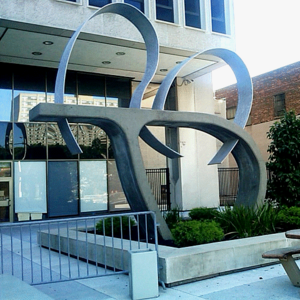Lila Katzen facts for kids
Quick facts for kids
Lila Katzen
|
|
|---|---|
| Born |
Lila Pell
December 30, 1925 Brooklyn, NY, USA
|
| Died | September 20, 1998 (aged 72) |
Lila Katzen (born Lila Pell on December 30, 1925, in Brooklyn, New York) was an amazing American artist. She was known for creating large, flowing sculptures out of metal. Lila passed away on September 20, 1998, in New York City.
Contents
Becoming a Sculptor
Lila grew up in Brooklyn. She went to Cooper Union and also studied with a famous artist named Hans Hofmann. She learned from him in New York City and Provincetown, MA.
Her first art show was in 1955 at the Baltimore Museum of Art. At that time, she was a painter. Later, she had more shows in places like Alabama and Kansas. From 1962 to 1980, Lila taught art at the Maryland Institute, College of Art.
From Painting to Sculpture
Lila's art teacher at Cooper Union told her she should only be a painter. He thought she wanted things to happen too fast for sculpture. But Lila loved to experiment!
Her early paintings were abstract. This means they didn't show real objects. She took parts of figures and connected them to space. As she got better at painting, Lila looked for new challenges.
She started making collages on canvas. Then she painted on nylon fabrics. But even nylon felt too limiting. So, in the late 1950s, Lila began painting on acrylic sheets.
Exploring Light in Art
Painting on acrylic helped Lila move into sculpture. She experimented with fluorescent paints and backlights. She used light itself as a material.
In one piece called The Pressure Light, Lila found that light was more interesting when it mixed with its surroundings. This made her explore how light works. She saw how light could be inside her art, but also reach out to include the people watching it.
Big Metal Sculptures
Lila's experiments with light led her to create Light Floors in 1968. This art piece was shown at the Architectural League in New York City. Light Floors had geometric shapes. It was spread across the floors of three rooms in the gallery. Yellow and ultraviolet lights shone through the acrylic in different patterns.
Lila continued to use light in her art. She made The Universe is the Environment (1969). She also created Liquid Tunnel, which was an eight-sided tunnel. It had fluorescent light shining through water. This played with how light looks through different materials.
Making Metal Flow
In the early 1970s, Lila became famous for her sculptures. She made well-known works like Slip Edge Bliss (1973) and Trajho (1973). These sculptures showed how flexible materials could be.
Lila stretched and shaped metals like steel and aluminum. She made them look soft and flowing, like ribbons. She had to work quickly and know exactly what she wanted. She said, "No chance for mistakes. You can’t reroll it. It’ll lose its elasticity."
She started with thin metal sheets. Then she would shape and fold the material with her fingers. She made the cold steel feel warm and alive. One art writer said her sculptures curved like "voluptuous ribbon."
Art for Everyone
Many of Lila's sculptures are large outdoor pieces. They are made to fit in with their surroundings. This goes back to her early ideas about light.
Lila also designed her sculptures to be interactive. Unlike some artists who wanted people to just look, Lila invited people to touch her art. You could sit, swing, lie down, or even crawl under them. Lila felt a strong connection to her art. She thought of her sculptures like her children. She was happy when her works found a new home.
Later Art and Ideas
In the 1970s, Lila's sculptures were known for their smooth, curvy shapes. They were often called "lyrical," meaning beautiful and flowing. But in the early 1990s, she started making new art.
These new pieces were made of sharp, jagged steel. One writer described them as "harsh and aggressive." They showed a more broken and delicate world. Some of these works were in an exhibition in 1992. They included "Exploration Queen" and "Alligator Queen." These pieces created an imaginary picture of Queen Isabella of Castille.
Another show of her later work was in 1995. It included sculptures like Nerve Threads and Paleolithic Map. An art curator named Dana Self noted that Lila's earlier works were often smooth and graceful. Lila was inspired by artists like Bernini, who made sculptures that seemed to float.
But in her new sculptures, Lila changed her style. She wanted to show current social issues in her art. She used a "harsh and aggressive style" to talk about the present world.
Lila's art can be found in many important collections. These include the National Gallery of Art in Washington, DC, and the J. Paul Getty Museum.
Fighting for Fairness
Lila Katzen was also a strong supporter of the feminist movement in art. This movement worked to make things fair for women artists. Lila spoke out against unfair treatment based on gender.
She shared her own experiences. Her teacher, Hans Hofmann, supported her in the studio. But he got upset when he realized she was serious about her art career. Once, at a dinner party, Hofmann made a toast saying, "Only the men have the wings." Lila was very angry and they argued.
Because Lila was so open about her feminism, her art was sometimes seen differently. A review in The New York Times even connected her art to her "militant feminism."
Lila was included in a famous feminist artwork by Mary Beth Edelson. This piece, called Some Living American Women Artists / Last Supper (1972), changed Leonardo da Vinci’s The Last Supper. It put the faces of important women artists, including Lila, over the original figures. This artwork became a very important symbol of the feminist art movement.


